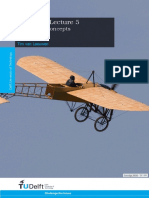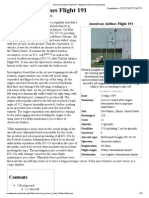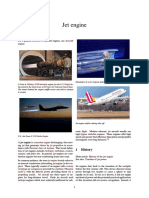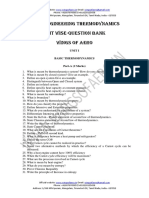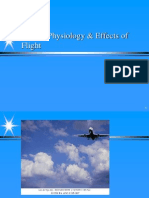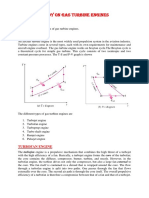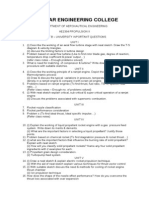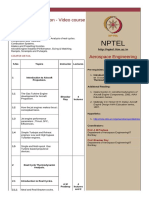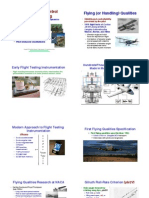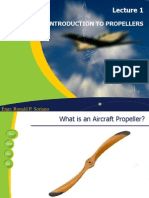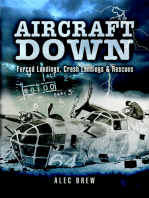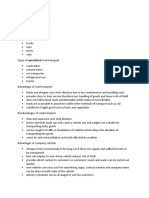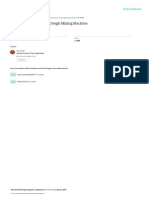Cooling Jeppeson
Cooling Jeppeson
Uploaded by
Sutanu MishraCopyright:
Available Formats
Cooling Jeppeson
Cooling Jeppeson
Uploaded by
Sutanu MishraCopyright
Available Formats
Share this document
Did you find this document useful?
Is this content inappropriate?
Copyright:
Available Formats
Cooling Jeppeson
Cooling Jeppeson
Uploaded by
Sutanu MishraCopyright:
Available Formats
AFT VERTICAL CYLINDER HEAD BAFFLE- TO-COWL SEALS RUBBER SEAL UPPER COWL
BAFFLE
;7
_ jFIREWALl
LOWER COWL RUBBER SEAL
On some aircraft, the amount of cooling air that flows into the cowling is controlled through the use of cowl flaps. Cowl flaps are hinged doors that are installed at the bottom rear of the cowling where the cooling air exits. When the cowl flaps are open, a stronger low pressure area is created in the lower cowl and more air is pulled through the cylinders. On the other hand, when the cowl flaps are closed, the low pressure area becomes weaker and less cooling air is drawn between the cylinders. The position of the cowl flaps is controlled from the cockpit and are typically operated manually, electrically, or hydraulically. [Figure 10-6] Cowl flaps are typically in the full open position during all ground operations. The reason for this is that, while operating on the ground, airflow through the cowling is greatly reduced. However, once an aircraft is established in level flight, more air is forced into the cowling. This allows the cowl flaps to be closed so that the drag produced by the cowl flaps can be eliminated.
Augmenter tubes may be used on some aircraft to augment, or increase, the airflow through the cylinders. Like cowl flaps, augmenter tubes create a low pressure area at the lower rear of the cowling in order to increase the airflow through the cylinder cooling fins. [Figure 10-7]
Figure 10-6. By installing cowl flaps on an aircraft, the operator can control the amount of air that flows into the cowling.
INTER-CYLINDER BAFFLES
AUGMENTER TUBE ~ AMBIENT EXHAUST AIR
Figure 10-7. Some reciprocating engines use augmenter tubes to improve engine cooling. As exhaust gases flow from each exhaust collector into an augmenter tube, an area of low pressure is created which draws additional cooling air over the engine cvlinders.
In an augmenter system, the exhaust gases from the engine are routed into a collector and discharged into the inlet of a stainless steel augmenter tube. The flow of high-velocity exhaust gases creates an area of low pressure at the inlet of the augmenter tube and draws air from above the engine through the cylinder fins. The combination of exhaust gases and cooling air exits at the rear of the augmenter tube.
the baffles structure.
and are an integral
part of the baffle
Many engine installations use blast tubes to direct cooling air in to inaccessible areas of an engine compartment. A blast tube is basically a small pipe or duct that channels air from the main cooling airstream onto heat-sensitive components. Engine accessories such as magnetos, alternators, and generators are often cooled using blast tubes. Blast tubes, where used, are typically built into
Helicopters present unique problems when it comes to cooling an engine. For example, helicopter engines generally operate at a high rpm for prolonged periods of time and, therefore, produce more heat. Furthermore, helicopters typically fly at much slower airspeeds than fixed-wing aircraft and do not benefit from ram airflow. Since the downwash from the main rotor is insufficient to cool an engine an alternate method of engine cooling is required. The most commonly used auxiliary engine cooling system in helicopters is a large belt-driven cooling fan. As an example of a helicopter cooling fan assembly, consider the Bell 47 helicopter. The cooling fan is mounted on the front side of the engine and is dri-
In spite of the disadvantages, liquid-cooled engines were used with great success in some American and British-built WWII fighter aircraft. Two such aircraft were the P-38 Lightning and P-51 Mustang which flew with liquid-cooled V-12 engines. A recently produced liquid-cooled engine, the TeledyneContinental Voyager, uses a mixture of 60 percent ethylene glycol and 40 percent water as a coolant. The coolant is circulated at a high velocity and the small radiator is located in an area which produces the least amoun t of drag.
TEMPERATURE INDICATING SYSTEMS
The engine temperature can have a dramatic impact on engine performance. Therefore, most reci procating engine powered aircraft are equipped with a cylinder head temperature (CHT) gauge that allows you to monitor engine temperatures.
Figure 10-8. The cooling fan assembly on a Bell 47 helicopter is rotated by two V-belts that are driven by the engine transmission.
ven by the transmission fan quill assembly through two matched V-belts. The 1.2:1 quill gear ratio turns the fan at a higher speed than the engine in order to distribute an adequate supply of cooling air to the engine. I Figure 10-8J
Most cylinder head temperature gauges are galvanometer-type meters that display temperatures in degrees Fahrenheit. If you recall From your study of electricity, a galvanometer measures the amount of electrical current produced by a thermocouple. A thermocouple is a circuit consisting of two dissimilar metal wires connected together at two junctions to form a loop. Anytime a tem perature difference exists between the two junctions, a small electrical current is generated that is proportional to the temperature difference and measurable by the galvanometer. The two junctions of a thermocouple circuit are commonly referred to as a hot junction and a cold junction. The hot junction is installed in the cylinder head in one of two ways; the two dissimilar wires may be joined inside a bayonet probe which is then inserted into a special well in the top or rear of the hottest cylinder, or the wires may be imbedded in a special copper spark plug gasket. The cold junction, or reference junction, on the other hand, is typically located in the instrument case. Thermocouple instrument systems are polarized and extremely sensitive to resistance changes within their electrical circuits. Therefore, several precautions must be observed when replacing or repairing them. First, be sure to observe all colorcoding and polarity markings because accidentally reversing the wires causes the meter to move offscale on the zero side. In addition, ensure that all electrical connections are clean and torq ued to the correct value.
Liquid-cooled aircraft engines are constructed with a metal water jacket that surrounds the cylinders. As coolant circulates in the water jacket, heat passes [rom the cyl in del' walls and heads to the coolant. A coolant pump circulates the coolant in a pressurized loop from the water jacket to a radiator, where heat is transferred from the coolant to the air. To allow for higher engine temperatures and a smaller radiator, many liquid-cooled systems are pressurized. Although liquid-cooled engines have been the standard for automotive and industrial engines for years, they have had limited success in aircraft. Early aircraft engine designs used liquid cooling; however, new air-cooled engine designs became the standard for several reasons. The primary reason for this is that the need for a radiator, water jacket, coolant, and other associated hoses and lines added a substantial amount of weight. In addition, aircooled engines are not hampered by cold-weather operations as severely as liquid-cooled engines.
rhermocouple wlnng leads are typically supplied nmatched pairs and secured together by a common raid.Furthermore, the leads are a specified length, latched to the system to provide accurate temperaIreindications. The length of the leads cannot be tteredbecause doing so changes their resistance. In )me cases, the wiring leads are permanently tached to a thermocouple, necessitating the placement of the entire wiring harness and therocouple if a wire breaks or becomes damaged. mple CHT systems use a single indicator that mitors the hottest cylinder. With this type of sysn, overall engine temperature must be interpreted a general way. There are, however, more complex ;tems which monitor each cylinder and can be set warn you when a cylinder approaches its maxim temperature limit.
accordance with the manufacturer's instructions. Early detection of breaks and cracks provide an opportunity to limit the damage and extend the service life of a cowling.
The condition of the cooling fins plays a large role in their effectiveness and ability to provide adequate cylinder cooling. Therefore, cylinder cooling fins must be checked during each regular inspection. The cooling fins on an engine are designed with a precise surface area to dissipate a certain amount of heat. Therefore, when cooling fins are broken off a cylinder, less fin area is available for cooling. An engine's fin area is the total area (both sides of the fin) exposed to the air. Anytime an excessive amount of fin area is missing, the formation of hot spots can occur on the cylinder. The amount of fin damage permitted on a given cylinder is based on a percentage of the total fin area and is established by the manufacturer. Therefore, when performing repairs to a cylinder's cooling fins. the engine manufacturer's service or overhaul manual should be consulted to ensure the repair is within limits. Generally, cracks in cooling fins which do not extend into the cylinder head may be repaired. A typical repair requires you to remove the damaged portion of the fin with a die grinder and rotary file. After removing the damage, finish file the sharp edges to a smooth contour. The percentage of total fin area that is removed must not exceed the limits established by the manufacturer. IFigure 10-9] Cracks drilled at the edge of a fin may be filed or stop to prevent the crack from lengthening. In
cooling system components should be inspected ing a loO-hour or annual inspection. In addition, e a thorough visual inspection is complete, it Llldbe followed up with all necessary repairs or acemen(s. Some of the components that are typy inspected include the cowling, cylinder fins, ing, and cowl flaps.
au recall, only 15 to 30 percent of the total ram )\'\1 enters the cowling. Therefore, the aerodyic shape of a cowling must be clean and smooth duce drag and energy loss. This smoothness be considered when accomplishing any rs to a cowling or adjusting alignment of cowl Is and access doors. panels must be visually inspected for dents, and cracks. Such damage causes weakness in anel struct ure and increases drag by disrupthe airflow. Furthermore, accumulations of and tears can lead to cracking and contribute rrosion. Internal construction of cowl panels d be examined closely to ensure that the rein19 ribs are not tracked and that the air seal is ~maged. :owl panel latches shou!c. be inspected for 19 rivets and loose or damaged handles. In on, you should check the safety locks for dam'ivets and the condition of the safety spring. ne all support brackets carefully to verify the ty of mounting and repair any cracks found in
MAX. FIN REMOVAL, NEVER ENTER BASE METAL
Figure 10-9. When repairing a damaged fin on a cylinder, you must not remove any of the primary cylinder casting. In addition, fin loss near spark plug openings or exhaust ports can cause dangerous local hot spots.
You might also like
- Assignment 5Document7 pagesAssignment 5José A. Montiel Quirós0% (1)
- American Airlines Flight 191 - Wikipedia, The Free EncyclopediaDocument10 pagesAmerican Airlines Flight 191 - Wikipedia, The Free EncyclopediacomandantedaniloNo ratings yet
- Sam MalofDocument5 pagesSam MalofMarcos SalazarNo ratings yet
- Jet EngineDocument14 pagesJet EngineعبداللهأحمدNo ratings yet
- Aero Engineering Thermodynamics PDFDocument22 pagesAero Engineering Thermodynamics PDFSridharanNo ratings yet
- Powerware 9330 UPS Installation & Operation Manual 10-40 KVADocument268 pagesPowerware 9330 UPS Installation & Operation Manual 10-40 KVADiego Grant100% (1)
- Piston Cooling SystemDocument31 pagesPiston Cooling SystemAfiq ZikriNo ratings yet
- T11, Section 2, Ground HandlingDocument52 pagesT11, Section 2, Ground HandlingDavid WongNo ratings yet
- Lecture 2 - Physiology and Effects of FlightDocument99 pagesLecture 2 - Physiology and Effects of Flightzuliana_ismail8564No ratings yet
- Unit - 3 Types of Gas Turbine EnginesDocument4 pagesUnit - 3 Types of Gas Turbine EnginesAnonymous VKv75qe98100% (1)
- Mil S 9479B PDFDocument42 pagesMil S 9479B PDFVijet BhandiwadNo ratings yet
- Squadrons 4Document2 pagesSquadrons 4ZZBDUNo ratings yet
- Sheet Metal 2-01-09Document9 pagesSheet Metal 2-01-09Adrianne AstadanNo ratings yet
- Annular Wing CraftDocument2 pagesAnnular Wing CraftCalvin NgNo ratings yet
- 27th FS A History of FirstsDocument4 pages27th FS A History of FirstsMarc Matthew CzyganNo ratings yet
- Griffon 65Document8 pagesGriffon 65asscracker9000No ratings yet
- Lavi 5Document10 pagesLavi 5Daniel Madrid100% (1)
- F22 RaptorDocument2 pagesF22 RaptorKakhaNo ratings yet
- MIDTERM Lesson 1 MSGDocument24 pagesMIDTERM Lesson 1 MSGJohn Ericsson RobariosNo ratings yet
- Introduction To Aircraft Engines: Tieying WuDocument54 pagesIntroduction To Aircraft Engines: Tieying WuDennis Padec BwochengoNo ratings yet
- Aviation Maintenance Crew ChiefDocument2 pagesAviation Maintenance Crew ChiefAlex LakeNo ratings yet
- 100 Years of Vortex Theory PDFDocument25 pages100 Years of Vortex Theory PDFManuel ZúñigaNo ratings yet
- Lectures 1 To 3 PDFDocument34 pagesLectures 1 To 3 PDFdev burmanNo ratings yet
- Wind Tunnel Investigation of PropellerDocument59 pagesWind Tunnel Investigation of PropellerMol MolNo ratings yet
- Propulsion II Very Important Note QuestionsDocument5 pagesPropulsion II Very Important Note Questionsmerinchristo100% (2)
- Seminar On Jet Engine: Submitted To: Submitted byDocument20 pagesSeminar On Jet Engine: Submitted To: Submitted bypavan kalyanNo ratings yet
- National Advisory Committee For Aeronautics: FM?RMWW - . Not ToDocument19 pagesNational Advisory Committee For Aeronautics: FM?RMWW - . Not ToMir Mustafa AliNo ratings yet
- Types of DragDocument3 pagesTypes of DragSwetha SharmaNo ratings yet
- Engine - Servicing: Item No. NameDocument31 pagesEngine - Servicing: Item No. NameSamirnov IcNo ratings yet
- Fundamentals of Modern AviationDocument8 pagesFundamentals of Modern Aviationascera100% (1)
- Aspects of Aero-Engine Nacelle Drag-2018Document24 pagesAspects of Aero-Engine Nacelle Drag-2018Lam Trinh NguyenNo ratings yet
- XLR129 P 1 DemEngineDesign V3Document214 pagesXLR129 P 1 DemEngineDesign V3nab05No ratings yet
- Airfoils and LiftDocument28 pagesAirfoils and LiftRajeev C NairNo ratings yet
- 101101002Document6 pages101101002Ahmed shawkyNo ratings yet
- Principles of Flight: Presented by Group - 1Document32 pagesPrinciples of Flight: Presented by Group - 1Anonymous VKv75qe98No ratings yet
- Aircraft Landing Gear System: Presented By: Rishikesh K. Singh Roll No. 134103054 Guided by Dr. Ujjwal Kumar SahaDocument39 pagesAircraft Landing Gear System: Presented By: Rishikesh K. Singh Roll No. 134103054 Guided by Dr. Ujjwal Kumar SahaindahNo ratings yet
- DesignDocument9 pagesDesignSamx80No ratings yet
- Airpower and Technology Smart and Unmanned WeaponsDocument246 pagesAirpower and Technology Smart and Unmanned WeaponsCsaba FeketeNo ratings yet
- Aircraft Engine DevelopmentDocument9 pagesAircraft Engine DevelopmentvikramvivNo ratings yet
- Flying Qualities (Princeton MAE331 Lecture17)Document11 pagesFlying Qualities (Princeton MAE331 Lecture17)eeebbbuuuNo ratings yet
- Department of Aeronautical / Aerospace Engineering U20AE301 - Aero Engineering Thermodynamics 50 Big QuestionsDocument8 pagesDepartment of Aeronautical / Aerospace Engineering U20AE301 - Aero Engineering Thermodynamics 50 Big QuestionsGurunath AeroNo ratings yet
- Parts of An AircraftDocument29 pagesParts of An Aircrafttsegay100% (1)
- 2 Marks - U20AE301 AET - DS R2020 - 20210713 - SDocument18 pages2 Marks - U20AE301 AET - DS R2020 - 20210713 - SGurunath AeroNo ratings yet
- Activity No. 1 Design ConceptDocument2 pagesActivity No. 1 Design ConceptAya DhengNo ratings yet
- Introduction To Aircraft Reciprocating EngineDocument4 pagesIntroduction To Aircraft Reciprocating EngineGerald CaparasNo ratings yet
- Pneumatic SystemDocument5 pagesPneumatic SystemArchanaSinghPrajapatiNo ratings yet
- Aircraft Primary ControlDocument18 pagesAircraft Primary ControlYadanaNo ratings yet
- HistoryDocument3 pagesHistoryjjj1728100% (1)
- LOM Praha Piston EnginesDocument9 pagesLOM Praha Piston EnginesRainer NybergNo ratings yet
- Rocker Gear and ValvesDocument10 pagesRocker Gear and ValvesBharatiyulamNo ratings yet
- Construction Details PDFDocument58 pagesConstruction Details PDFP.Prem Kumar AP - I - MechanicalNo ratings yet
- Thermal Engineering QP AuDocument14 pagesThermal Engineering QP AusaisenthNo ratings yet
- Materials in Aerospace NotesDocument2 pagesMaterials in Aerospace NotesRamadhanìe Dwìe NtanNo ratings yet
- Design of A Manned Vehicle Technical ReportDocument215 pagesDesign of A Manned Vehicle Technical ReportEstrella de SánchezNo ratings yet
- Wind TreeDocument18 pagesWind TreeA48Rayan PereiraNo ratings yet
- Lecture 1 AMT 113Document42 pagesLecture 1 AMT 113Jaafar SorianoNo ratings yet
- Ageing Management and Long Term Operation of Nuclear Power Plants: Data Management, Scope Setting, Plant Programmes and DocumentationFrom EverandAgeing Management and Long Term Operation of Nuclear Power Plants: Data Management, Scope Setting, Plant Programmes and DocumentationNo ratings yet
- Aircraft Down: Forced Landings, Crash Landings and RescuesFrom EverandAircraft Down: Forced Landings, Crash Landings and RescuesRating: 3 out of 5 stars3/5 (1)
- Cables Accreditation CatalogueDocument80 pagesCables Accreditation CatalogueMostafa EL-AttarNo ratings yet
- 17 Quality Characteristics EngineeringDocument20 pages17 Quality Characteristics EngineeringAries Sunanda100% (1)
- BSDocument8 pagesBSProject AtomNo ratings yet
- Ussor AorDocument1 pageUssor AorArun K RajNo ratings yet
- MassMin 2016 Super CavesDocument8 pagesMassMin 2016 Super CaveskinsaeyaNo ratings yet
- BOP Winch Documents For Rig 74Document33 pagesBOP Winch Documents For Rig 74gamalyehia130% (1)
- Transportation Engineering I: Rajesh Khadka Department of Civil Engineering AcemDocument64 pagesTransportation Engineering I: Rajesh Khadka Department of Civil Engineering AcemRajesh KhadkaNo ratings yet
- Mechanical GovernorDocument14 pagesMechanical GovernorSrêyas Raj PkNo ratings yet
- VP Sales Marketing Business Development in Alpharetta GA Resume Lawrence BridgerDocument3 pagesVP Sales Marketing Business Development in Alpharetta GA Resume Lawrence BridgerLawrenceBridgerNo ratings yet
- XML ImplementationDocument10 pagesXML ImplementationPraveen KumarNo ratings yet
- Complete ReportDocument95 pagesComplete ReportJacques Martin0% (1)
- Data ArchivingDocument63 pagesData ArchivingHot_sergio100% (1)
- HMDDocument3 pagesHMDbonnyi20No ratings yet
- 2023 Winter Question Paper (Msbte Study Resources)Document4 pages2023 Winter Question Paper (Msbte Study Resources)misbahul2004No ratings yet
- CP Reveal F61e Et L38e DEF. GB F980C371Document14 pagesCP Reveal F61e Et L38e DEF. GB F980C371samabuelsamidNo ratings yet
- Justin Noble Obisike Cv...Document2 pagesJustin Noble Obisike Cv...Justin ObisikeNo ratings yet
- Commerce Notes Abt TransportationDocument5 pagesCommerce Notes Abt TransportationShean Lim100% (1)
- Enterprise Resource Planning (ERP)Document25 pagesEnterprise Resource Planning (ERP)Nawaz AhmedNo ratings yet
- Lecture 4 TBT 2 Hoisting Systems and Pipe Handling SystemsDocument109 pagesLecture 4 TBT 2 Hoisting Systems and Pipe Handling SystemsTyo DekaNo ratings yet
- Cobalt Chromium Implant Grade TubingDocument2 pagesCobalt Chromium Implant Grade Tubingkunalkp88No ratings yet
- Complete Quality Manual of Garments Factory PDFDocument11 pagesComplete Quality Manual of Garments Factory PDFGAURAV SHARMANo ratings yet
- WSL Brochure Dec.2008Document20 pagesWSL Brochure Dec.2008Aníbal Mellano100% (1)
- Aluminium AlloysDocument43 pagesAluminium AlloysArg SreekarNo ratings yet
- Engineering FAN Guide A-108 PDFDocument24 pagesEngineering FAN Guide A-108 PDFPrak Rem0% (1)
- TL 071Document47 pagesTL 071Pankaj K YadavNo ratings yet
- Designof Power Driven Dough Mixing MachineDocument5 pagesDesignof Power Driven Dough Mixing MachineGocozzy CommerceNo ratings yet
- Two-Dimensional Airfoil TheoryDocument28 pagesTwo-Dimensional Airfoil TheoryNavaneeth Krishnan BNo ratings yet
- Aximax 2HL 3698SF FanDocument3 pagesAximax 2HL 3698SF FanDhanus KodiNo ratings yet
